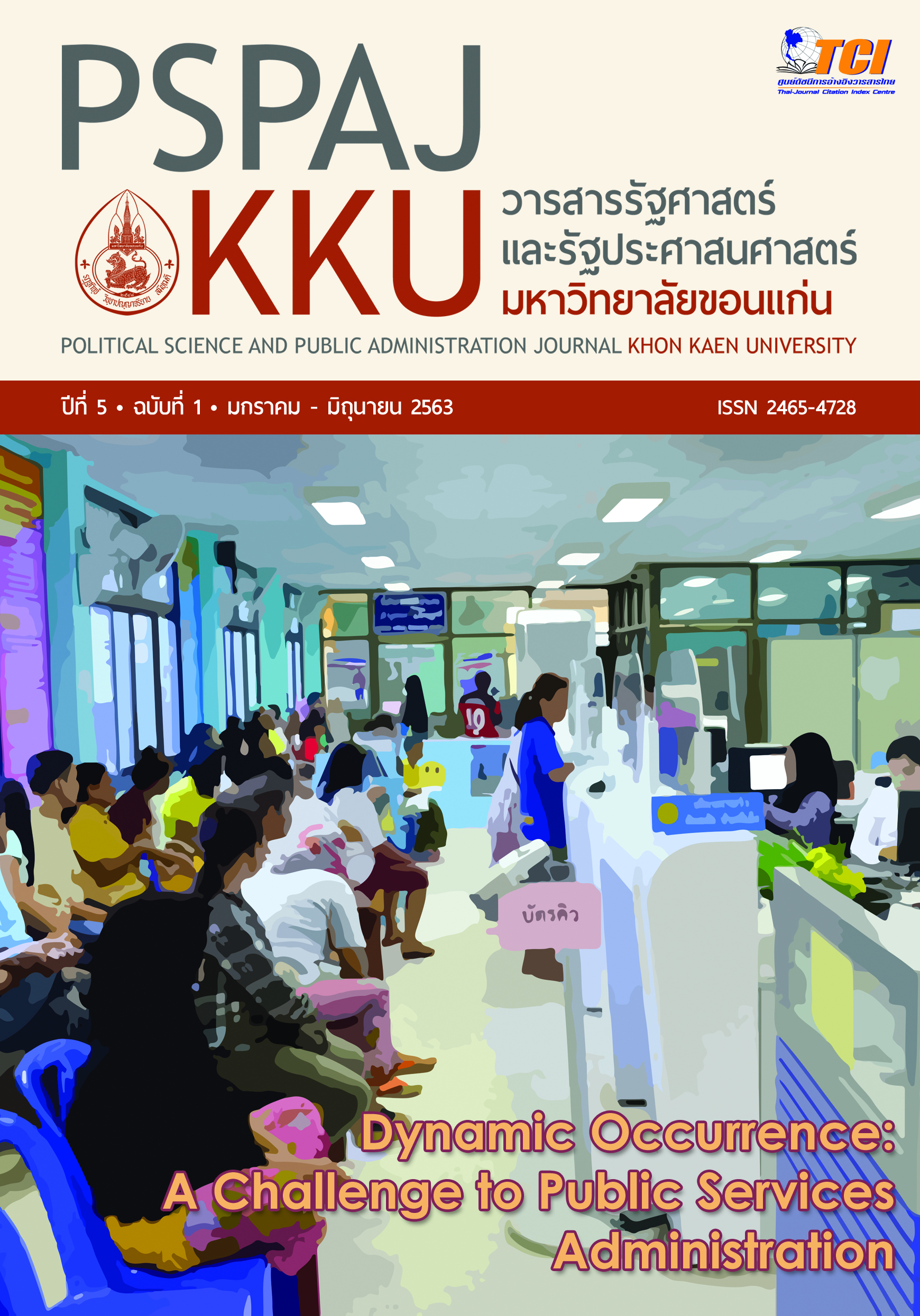การควบคุมระบบราชการโดยการเมือง
Main Article Content
บทคัดย่อ
บทความนี้มีวัตถุประสงค์เพื่ออภิปรายถึงความสัมพันธ์ระบบราชการกับการเมืองแบบประชาธิปไตยภายใต้ประเด็นปัญหาร่วมระหว่างการเมืองกับการบริหาร นั่นคือ ปัญหาความตึงเครียดของระบบราชการกับประชาธิปไตย บทความนี้ตั้งคำถามหลักว่า ทำอย่างไรระบบราชการซึ่งเป็นกลไกที่ไม่เป็นประชาธิปไตยจึงจะสามารถอยู่ร่วมกับกระบวนการทางการเมืองและการใช้อำนาจสาธารณะที่เป็นประชาธิปไตย และ ควรมีระบบควบคุมทางการเมืองที่เกี่ยวข้องในลักษณะใด บทความนี้จึงเริ่มต้นโดยการสำรวจแนวคิดระบบราชการ เพื่อชี้ให้เห็นถึงตรรกะ ชุดคุณค่า และบทบาทของระบบราชการที่อาจขัดกับหลักการประชาธิปไตย และตั้งข้อถกเถียงกับแนวคิดทฤษฎีกระแสหลักอย่าง ทฤษฎีตัวการ - ตัวแทน ซึ่งเสนอกลไกการควบคุมระบบราชการที่สำคัญ ได้แก่ การควบคุมโดยนักการเมืองที่มาจากการเลือกตั้ง และในตอนท้ายของบทความผู้เขียนได้นำเสนอการควบคุมระบบราชการภายใต้แนวคิดการบริหารปกครอง (Governance) พร้อมทั้งได้อภิปรายถึงศักยภาพและความเป็นไปได้ของการควบคุมระบบราชการด้วยกลไกทางเลือกอื่น ได้แก่ (1) การควบคุมด้วยค่านิยมภายในระบบราชการเอง (2) การควบคุมโดยสำนึกระบบราชการเป็นผู้แทนประชาชน (3) การควบคุมโดยคณะกรรมการควบคุมการดำเนินงาน และ (4) การควบคุมโดยเครือข่าย
Article Details
เอกสารอ้างอิง
2. Antonio, R.J. (1979). The contradiction of domination and production in bureaucracy: the contribution of organizational efficiency to the decline of the Roman
Empire. American Sociological Review, 44, pp. 895-912.
3. Banks, Jeffrey S. (1989). Agency budgets, cost information, and auditing. American Journal of Political Science. 33, pp. 670-699.
4. Banks, Jeffrey S., & Weingast, Barry R. (1992). The Political Control of Bureaucracies under Asymmetric Information. American Journal of Political Science. 36(2), pp. 509-524.
5. Bendor, Jonathan, Serge Taylor, and Roland Van Gaalen. (1987). Politicians, Bureaucrats, and Asymmetric Information. American Journal of Political Science. 31, pp.796-828.
6. Blumstein, mes F. (2001). Regulatory Review by the Executive Office of the President: and Overview and Policy Analysis of Current Issues. Duke Law Journal. 51(3), pp. 851-899.
7. Calvert, Randall., McCubbins, Mathew D., & Weingast, Barry R. (1989). A Theory of Political Control and Agency Discretion. American Journal of Political Science. 33(3), pp. 588-611.
8. Caplan, B. (2007). The Myth of the Rational Voter: Why Democracies Choose bad Policies. Princeton: Princeton University Press.
9. Carrasco, G. (1991). Democracy’s interest in groups: Interest group corporatism and democratic theory. Master’s thesis. Simon Fraser University, Ottawa.
10. Christensen, J.G. (1999) Bureaucratic Autonomy as A Political Asset. Presented Paper at the Workshop Politicians, bureaucrats and institutional reform, ECPR Joint Sessions of Workshops Mannheim, March 26-31. From https://ecpr.eu/Filestore/PaperProposal/ec2df240-7984-43fc-bfc5-8e5ca1ad5756.pdf.
11. Corder, Kevin. (2003). Structural Choice and Political Control of Bureaucracy : Updating Federal Credit Programs. In Politics, Policy and Organization : Frontiers in the Scientific Study of Bureaucracy. Edited by George A. Krause; & Kenneth J. Meier. pp. 233-258. Ann Arbor: The University of Michigan Press.
12. Dworkin, Ronald (1997). Freedom's Law: The Moral Reading of the American Constitution. UK: Oxford University Press.
13. Eisenstadt, S. N. (1963, 1993). The political systems of empires: A study of bureaucratic societies. Glencoe: The Free Press.
14. Farazman, A. (1989). Bureaucracy, the State and Revolution in Modern Iran: Agrarian Reform and Regime Politics. New York: Praeger.
15. Farazman, A. (2009). Bureaucracy and Administration. Boca Raton: Taylor and Francis.
16. Farazman, A. (2010) Bureaucracy and Democracy: A Theoretical Analysis. Public Organization Review, 10, pp. 245-258.
17. Henisz, W.J. (2004). Political Institutions and Policy Volatility. Economics and Politics. 16(1), pp.1-27.
18. Hood, C., James, O., Peters, B. G., & Scott, C. (2004). Controlling modern government. Cheltenham: Edward Elger.
19. Huber, J., Shipan, C.R. & Pfahler, M. (2001). Legislatures and Statutory Control of Bureaucracy. American Journal of Political Science, 45(2), pp. 330-345.
20. Kagan, Elena. (2001). Presidential Administration. Harvard Law Review. 114(1), pp. 2245-2385.
21. Kelly, K. (2007). New View on North-South Relations of Imperialism. In A. Farazmand. Bureaucracy and Democracy: A Theoretical Analysis. Public Organization Review, (2010). 10, pp. 245-258.
22. Lessig,Lawrence; & Sunstein, Cass R. (1994). The President and the Administration. Columbia Law Review. 94(1), pp. 1-123.
23. Mair, Peter. (2006). Ruling the Void? The Hollowing of Western Democracy. New Left Review, 42, pp.25-51.
24. Marini, Frank. (1971). Toward a New Public Administration: The Minnowbrook Perspective. San Francisco, CA: Chandler.
25. Meier, K. J. & Nigro, L. G. (1976). Representative Bureaucracy and Policy Preferences: A Study in the Attitudes of Federal Executives. Public Administration Review. 36(4), pp. 458-469.
26. Meier, K., & O'Toole, L. J. (2006). Bureaucracy in a Democratic State A Governance Perspective. Baltimore: The John Hopkins University Press.
. (2006). Political Control versus Bureaucratic Values: Reframing the Debate. Public Administration Review. 66(2), pp. 177-192.
27. Nye, Joseph S., Jr., Philip D. Zelikow., & David C. King. (1997), Why People Don’t Trust Government. Cambridge, MA: Harvard University Press.
28. Osborne, D., & Gaebler, T. (1992). Reinventing government: How the entrepreneurial spirit in transforming the public sector. Reading: Addison-Wesley.
29. Peters, B. Guy. (2010). Bureaucracy and Democracy. Public Organization Review. 10, pp.209-222.
30. Pierre, Jon, & B. Guy Peters. (2000). Governance, Politics, and the State. London: Macmillan.
31. Pollitt, C., & Talbot, C. (2004). Unbundled government: A critical analysis of the global trend to agencies, Quangos and Contractualisation. London: Routledge.
32. Rhodes, R. A. W. (1997) Understanding Governance: Policy Networks, Reflexivity, and Accountability. Buckingham, UK: Open University Press.
33. Riggs, F. (2009). Bureaucracy: A profound puzzle for Presidentialism. In A. Farazmand (Ed.), Bureaucracy and Administration (pp. 155-203). Boca Raton: Taylor & Francis.
34. Rohr, John A. (1986). To Run a Constitution: The Legitimacy of Administrative State. Lawrence: University Press of Kansas.
35. Rothstein, B. (2008). Creating political legitimacy: Electoral democracy versus the quality of governance. QoG working paper 2008: 2. Gothenberg: Quality of Governance Institute, University of Gothenberg.
36. Stephenson, Matthew C. (2005). Legislative Allocation of Delegated Power: Uncertainty, Risk, and the Choice between Agencies and Courts. Harvard Law and Economics Discussion Paper No. 506.
37. Stephenson, Matthew C. (2008). Optimal Political Control of the Bureaucracy. Michigan Law Review. 107(1), pp. 53-110.
Strauss, Peter L., & Sunstein, Cass R. (1986). The Role of the President and OMB in Informal Rulemaking. Administrative Law Review. 38, pp.181-208.
38. Waldo, D. (1948). The Administrative State. New York: Ronald.
39. Waldo, D. (1955). The Study of Public Administration. New York: Random House.
40. Waldo, D. (1971). Public Administration in a Time of Turbulence. Scranton, PA: Chandler.
41. Waldo, D.(1992). The enterprise of public administration. Novato: Chandler and Sharp.
42. Wamsley ,Gary L. (1990). “The Agency Perspective: Public Administrators as Agential Leaders.” In Refounding Public Administration, edited by Wamsley et al., pp.114-162. Newbury Park, CA: Sage.
43. Weber, Max. (1946). From Max Weber: Essays in Sociology. Translated and edited by H. H. Gerth and C. Wright Mills. Oxford: Oxford University Press.
44. Weber, Max. (1947). The theory of social and economic organizations. (trans: Parsons, A.M., Parsons, T.). New York: Free Press.
45. Wood, B. Dan., & Waterman, Richard W. (1991). The Dynamics of Political Control of the Bureaucracy. American Political Science Review. 85(3), pp. 801-828.


